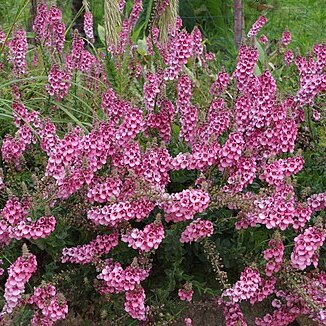Perennial herb, stems several from the crown, tufted, simple or sparingly branched, up to 1.3 m tall, 2-5 mm diam., erect or decumbent, glabrous. Leaves sometimes alternate upwards, usually crowded, mostly 15-60 x 10-37 mm, ovate, apex acute or subacute, apiculate, base cordate, margins sharply serrate, glabrous or thinly glandular-pilose, or glabrous below, glandular-puberulous on the inflorescence, thick-textured, sessile. Flowers many in crowded terminal racemes, which are often branched; bracts mostly 3-10 x 1-3 mm, ovate to linear-lanceolate, acute to acuminate; pedicels mostly 7-18 mm long, sharply ascending, glandular-pilose, hairs c. 0.3-0.6 mm long, sometimes sparse or entirely wanting. Calyx segments lanceolate, two anticous ones up to 2-4 x 1.25-1.5 mm; three posticous ones slightly smaller, glandular-pilose. Corolla tube c. 4-6 mm long, not invaginated, deeply channelled on the anticous side forming the keel, two lateral spurs c. 3 mm long, directed downwards, tips strongly incurved, with a patch of dark sessile glands within; limb c. 11-18 x 11-18 mm, anticous lobe subrotund, c. 5-8 x 7.5-11 mm, two lateral lobes broadly ovate, c. 4-5 x 4-6 mm, two posticous lobes ovate or subrotund, c. 3-5 x 3.5-5 mm, all lobes pale or rose-pink, sparsely glandular-pilose outside, glabrous inside except for stalked yellow glands on the keel, “window” shallowly concave, yellow and maroon. Stamens erect, filaments c. 2.5 mm long, glandular-puberulous; anthers 0.5-0.75 mm long, almost hidden under the upper lip, cohering strongly, pollen yellow. Ovary 0.75-1.25 x 0.75-1.25 mm, deltoid in outline, ovules many in each loculus; style 1 mm long, stigma capitate, lying between the anthers. Capsule c. 3-7 x 3-6 mm, ovoid; seeds c. 1.5 mm long, curved, winged and ridged.
More
Perennial herb, stems tufted, up to 1.3 m high, simple or little branched, erect or decumbent. Leaves ovate, ± acute and apiculate, thick in texture, sessile. Flowers crowded; pedicels ± 7-18 mm long, ascending. Corolla: tube forming a much-raised keel with dense patch of yellow, stalked glands; lobes shades of pink; window somewhat hollow. Spurs ± 3 mm long, projecting downwards with incurved tips.
A herb. It keeps growing from year to year. There are several stems that form tufts. It grows 1.3 m tall. The leaves are often crowded and 15-60 mm long by 10-37 mm wide. They are heart shaped at the base and have teeth along the edge.

